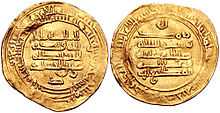Abu'l-Hasan Ali ibn al-Ikhshid

Abu'l-Hasan Ali ibn al-Ikhshid (Arabic: أبو الحسن علي بن الإخشيد) was the third ruler of the autonomous Ikhshidid dynasty, which ruled Egypt, Syria and the Hejaz.
He was a younger son of the dynasty's founder, Muhammad ibn Tughj al-Ikhshid,[1] and reigned from the death of his elder brother Unujur in 961. Actual power throughout his reign was held by the capable black eunuch Abu'l-Misk Kafur.[2] The main events of his reign were a Nubian invasion in 963, as well as a resurgence of Bedouin unrest and raids both in the Western Desert and in the Syrian Desert, in the latter case accompanied by the reappearance of the Qarmatians. Anti-Christian riots were provoked by a defeat of the Ikhshidid fleet against the Byzantine navy in 960/963, as well as the Byzantine offensives under Nikephoros Phokas in Cilicia and northern Syria.[3]
After Ali's death in January 966, Kafur sidelined his underage son Ahmad and became ruler in his own right.[4] Kafur ruled until his death in 968, when Ahmad succeeded him. The Ikhshidid state was weakened by internal turmoil and a succession of bad harvests, however, leading to its fall to the Fatimids in 969.[5]
References
- ↑ Bacharach 2006, pp. 60, 61.
- ↑ Bianquis 1998, pp. 115–116.
- ↑ Bianquis 1998, pp. 116–117.
- ↑ Bianquis 1998, p. 117.
- ↑ Bianquis 1998, pp. 117–118.
Sources
- Bacharach, Jere L. (2006). Islamic History Through Coins: An Analysis and Catalogue of Tenth-century Ikhshidid Coinage. Cairo: American University in Cairo. ISBN 9774249305.
- Bianquis, Thierry (1998). "Autonomous Egypt from Ibn Ṭūlūn to Kāfūr, 868–969". In Petry, Carl F. Cambridge History of Egypt, Volume One: Islamic Egypt, 640–1517. Cambridge: Cambridge University Press. pp. 86–119. ISBN 0-521-47137-0.
| Preceded by Abu'l-Qasim Unujur ibn al-Ikhshid |
Ikhshidid governor of Egypt, southern Syria and the Hejaz (de jure for the Abbasid Caliphate) 961–966 |
Succeeded by Abu'l-Misk Kafur |